Norwegian and Kloster
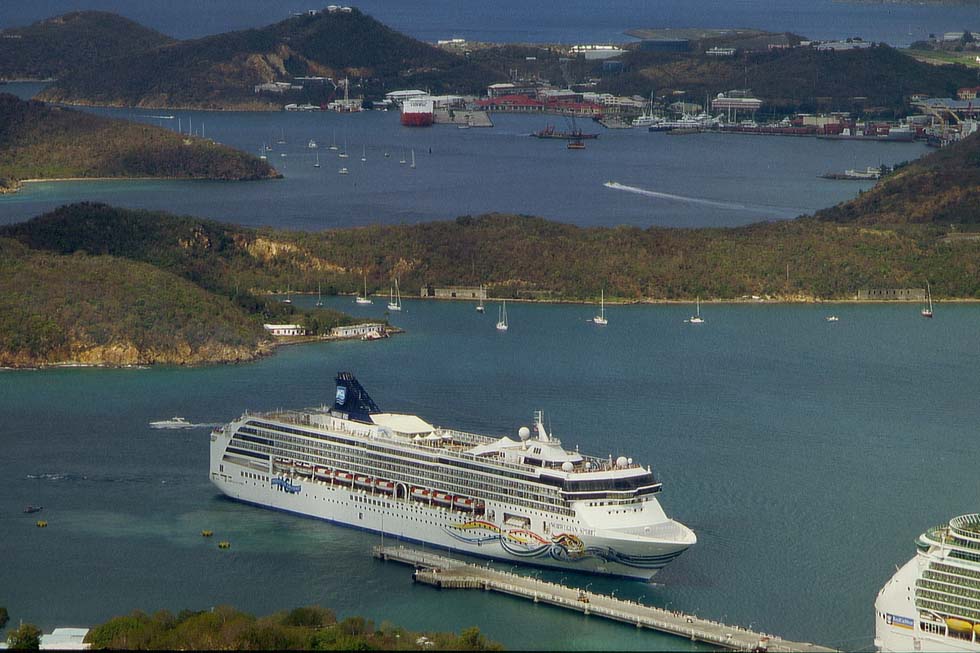
“Norwegian Spirit”, ex “Superstar Leo”, St.Thomas 2007 (WS)
Download this picture with 1500 x 1000 pix, 300 dpi

The start of modern cruising by Christian and Knut Kloster of Norway, primarily engaged in the cargo and tanker business, was described by ShipPax: “It was when late Ted Arison, who had costumers but no ship, met Knut Kloster, who had a ship but no customers, that modern-day cruising was invented (…). “Sunward” was sent from her ailing ferry operation between UK and Gibraltar to Miami, and the inaugural vessel instantly created a mass for more ships to come. Norwegian Caribbean Lines, as it was first called, was the real first marketing operator…” Historian Arnold Kludas delivered additional details: In November 1966, months after Arison’s deal with Somerfin Car Ferries of Haifa, Kloster offered the new car ferry “Sunward” of 8,666 tons and in December 1966 she started Caribbean cruises, joined in 1968 by the “Starward” (12,949 gt), in 1969 by the “Skyward” (16,254 gt, the first without car-carrying capacity) and in 1971 by the “Southward” (16,607 gt), all commissioned by the Klosters Rederi of Oslo. That was the start of modern cruising with new ships, not with old ocean liners. From 1968 foundation of Norwegian Caribbean Lines is reported. The “Seaward” was completed for P&O as “Spirit of London”.
Kloster and Arison separated in 1972 “after a bitter parting of ways”, as Frommer’s commented. The “Sunward” was replaced by the “Sunward II” (1971/14,110 gt, ex “Cunard Adventurer”), acquired in 1977. All these ships of Kloster featured a characteristic look with two parallel straddled funnels. They were sold between 1991 and 1995. The “Starward”, “Southward” and “Sunward II” were still alive in the 21st century as “Orient Queen” (then “Louis Aura”), Perla” and “Coral” of Louis Cruise Lines. The “Skyward” became the Asian casino-ship “Leisure World”.
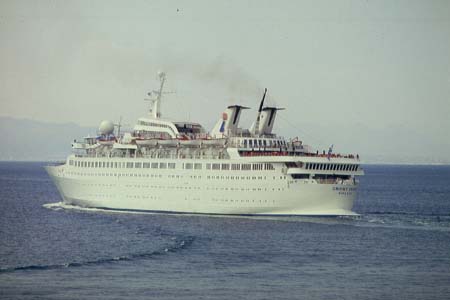
“Orient Queen” of Louis, the former “Starward” of Klosters, Saronic Gulf 2007 (WS)
|
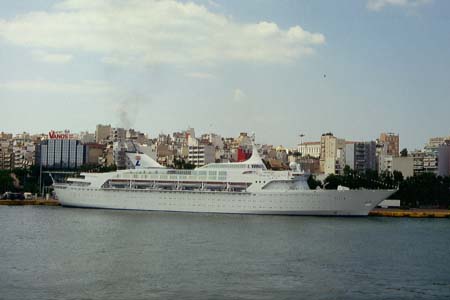
“Perla” of Louis, the former “Southward” of Klosters, Piraeus 2007 (WS)
|
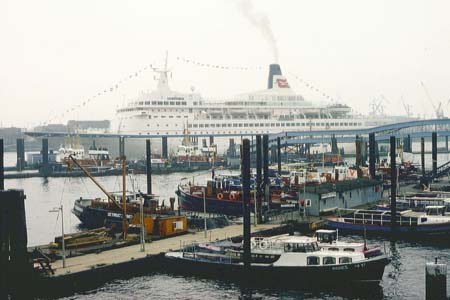
“Royal Viking Sky” of Royal Viking Line, Hamburg St.Pauli, 1982 (WS)
|
|
Competitors had emerged and opened a heavy struggle in the cruise market. The business was entered in 1968 by three new companies: Freeport Cruise Lines (which long since disappeared), Commodore Cruise Line (bankrupt in 2000) and Royal Caribbean (one of nowadays’ “big three”, see the relevant chapter). In 1970 three other enterprises, all of Norway, including Norske Amerikalinje, founded the Royal Viking Line. That company achieved an excellent reputation in the luxury market with their new cruise ships of the Royal Viking class (22,000 gt), introduced in 1972 and 1973, later measured with c.28,000 gt. The “Royal Viking Star”, “Royal Viking Sky” and “Royal Viking Sea” were acquired in 1984 by Norwegian Caribbean Lines, Oslo, and became registered in 1987/88 under the new designation Kloster Cruise Line. In the early ‘90s the aged ships were sold and the label Royal Viking was shut down. The “Royal Viking Star” (later “Westward”) survived as “Black Watch”, the “Royal Viking Sky” (temporarily “Sunward”, then “Birka Queen”) as “Boudicca”, both of Fred. Olsen Cruise Line, and the “Royal Viking Sea” (temporarily the “Royal Odyssey“ of Royal Cruise Line, then “Norwegian Star”) became after a confusing career the “Albatros” (II) on charter by Phoenix Reisen. Describing the final fate of all these ships would go beyond this worldwide survey.
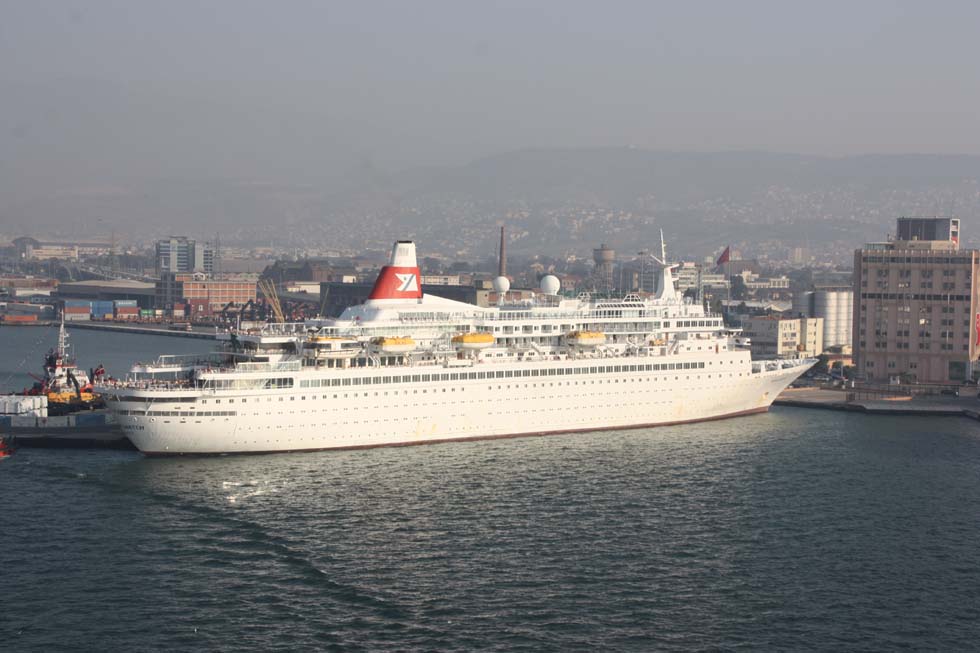
“Black Watch” of Fred. Olsen, ex “Royal Viking Star”, “Westward”, Izmir 2013 (Anton Soelch)
Norwegian Cruise Line
The Kloster family had bigger dreams. They dreamt of acquiring the laid-up Blue Riband winner “United States”, but U.S. laws prevented it and so she stood idle. Kloster purchased instead in 1979 the famous top-liner “France” of 1962, laid-up at Le Havre, from Akkram Ojeh of Saudi Arabia at a price of only 18 million dollars. At Bremerhaven she was rebuilt for Klosters R/A, her capacity being raised to 2,400 passengers, with increasing her gross tonnage from 66,343 to 70,702. To save fuel, four of the eight steam turbines and two of the four screws were removed, reducing the speed from 31 to 17-25 knots, sufficient for cruises. Renamed “Norway”, she was given a new blue and white painting. In 1980 diesel engines were added and in 1984 she was fully converted to diesel power. The “Norway” cruised in the Caribbean for Norwegian Caribbean Lines, then Kloster Cruise Ltd, and was praised as the “number one among world’s cruise ships”. In 1990 once again the capacity was risen, now to 2,560 pax. Additional decks did change her tonnage to 76,049. The “Norway” continued cruising for the Norwegian Cruise Line (NCL), the label adapted in 1987, until in 2003 a boiler explosion caused casualties among the crew. A friend told the story of a voyage aboard the “Norway” a few months before: The cabins showed still the ‘Art Deco’ design, but the aged vessel was “rockin’ and rolling” and very noisy. After the accident the ship was tugged to Bremerhaven, in 2005 to Port Klang and in 2006 as “Blue Lady” to Alang in India for scrapping. Lawyer disputes let rise some hope to get the ship saved, nevertheless the ex-“France”, one of the most beautiful ships ever built, was scrapped in 2008. It’s a tragedy.
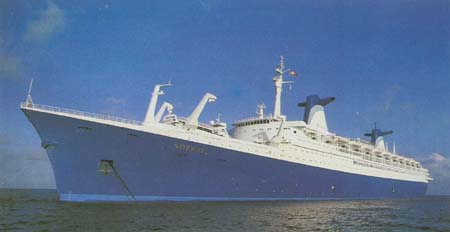 “Norway” (advertisement around 1981)
“Norway” (advertisement around 1981)
In 1977 Knut Utstein Kloster jun., son of Knut Kloster, planned the first ship for people to rent an apartment aboard. In the 80s he caused headlines with those plans for 250,000-ton megaships for the World City Corporation AS. However, the attempt had to be scaled down drastically – see the chapter Highlights and Attempts.
Realistically based was the introduction of new, conventional midsize ships for Kloster Cruise between 1988 and 1993, the “Seaward” (42,276 gt), the “Dreamward” (39,217 gt) and her sister “Windward”, both later stretched to c.50,760 gt, then renamed “Norwegian Sea”, “Norwegian Dream” and “Norwegian Wind”, to operate under the new label Norwegian Cruise Line. In 1989 Royal Cruise Line, founded in 1974 by Pericles Panagopoulos of Greece, was sold to the Kloster group, retaining for some time its identity (Panagopoulos changed to the car ferry business, creating Superfast Ferries). In 1996 Royal Star Cruise Line was closed down and its new “Crown Odyssey” (1988/34,242 gt) was transferred to Norwegian Cruise Line as “Norwegian Crown”. Also other vessels were taken over between 1995 and 1997: The “Norwegian Dynasty” (19,089 gt, ex “Crown Dynasty” of Commodore Cruise Line, then Cunard) and the “Norwegian Majesty” (commissioned as “Birka Queen”, completed in 1992 as the 32,396-ton “Royal Majesty” of Majesty Cruise Line, then extended at Bremerhaven). An interesting history had the “Leeward” (25,611gt). Completed in 1992 as “Sally Albatros” of Rederi Sally (like Silja and Baltic Express connected to the Effjohn lntl. Goup) for Baltic Sea services, she became in 1995 the “Leeward” of Norwegian Cruise Line, was then chartered out to Star Cruises as “Superstar Taurus”, returned to the Baltic Sea in 2002 as “Silja Opera” and continued her career in 2007 as “Cristal” of Louis Cruise Lines. The “Norwegian Majesty” became the “Louis Majesty” and also the “Norwegian Dream” should have been sold to Louis Cruises, but she was laid up in 2008 and in 2012 a transfer to Star Cruises was announced. The change of ships may continue, not listed here.
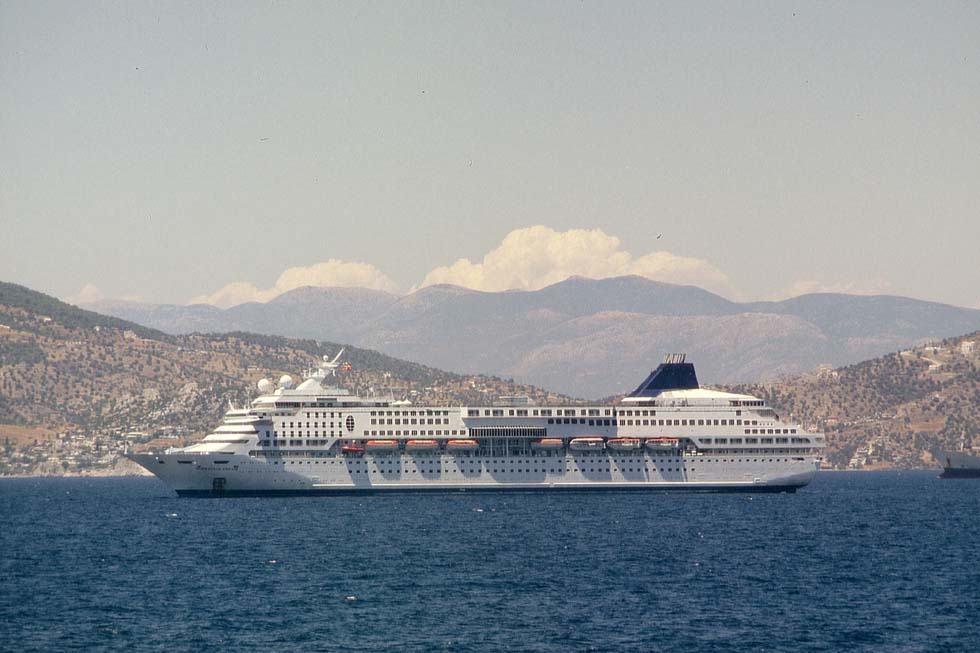
“Norwegian Dream”, ex “Dreamward”, Salamis 2009 (WS)
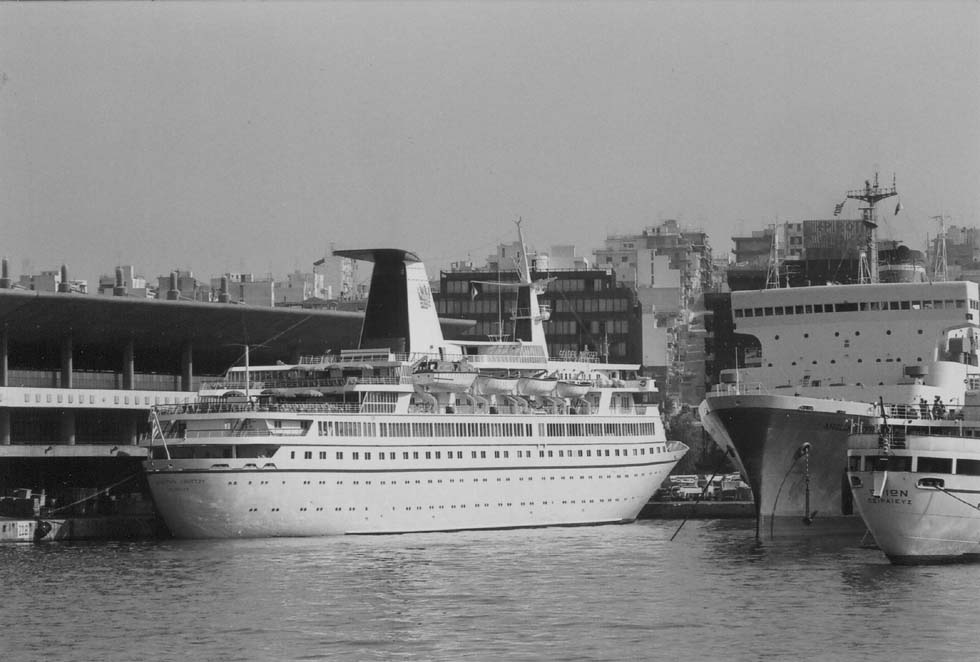
“Golden Odyssey” of Royal Cruise Line, Piraeus 1977 (WS)
“During this time, the Kloster family lost control of the company, and Klosters Cruises was renamed as NCL Holdings”, so reported by an informative Web site. In 1999 NCL went public and soon attracted a major shareholder, the mighty Genting Group of Malaysia, engaged in domestic tourism and owner of Star Cruise Lines. The report continued: “Yet the company also faced down a hostile takeover attempt from Carnival Cruise Lines. By 2000, however, Star Cruise had gained full control of NCL”.
The price mentioned by the press was 1.7 billion U.S. dollars. The aged, mixed fleet of midsize ships was to be transferred to Star Cruises or to be sold before 2009. The new ships “Norwegian Sky” (77,104 gt, initially commissioned by Costa), and the “Norwegian Sun” (78,309 gt) were delivered by Lloyd Werft in 1999 and 2001. The “Norwegian Spirit (77,000 gt, ex “Superstar Leo”) was added to the fleet in 2004. Acquisition by the Genting Group resulted in a programme for a splendid fleet. The 92,000-ton megaships with pod propulsion, built by the Meyer Werft, meant an advance for Norwegian Cruise Line. In the same year when Norwegian was acquired, the company abandoned formal dining and seating assignments, favouring casual dressing. The new concept was marketed under the label ‘Freestyle Cruising’, the hull of the ships being decorated with fancy paint schemes.
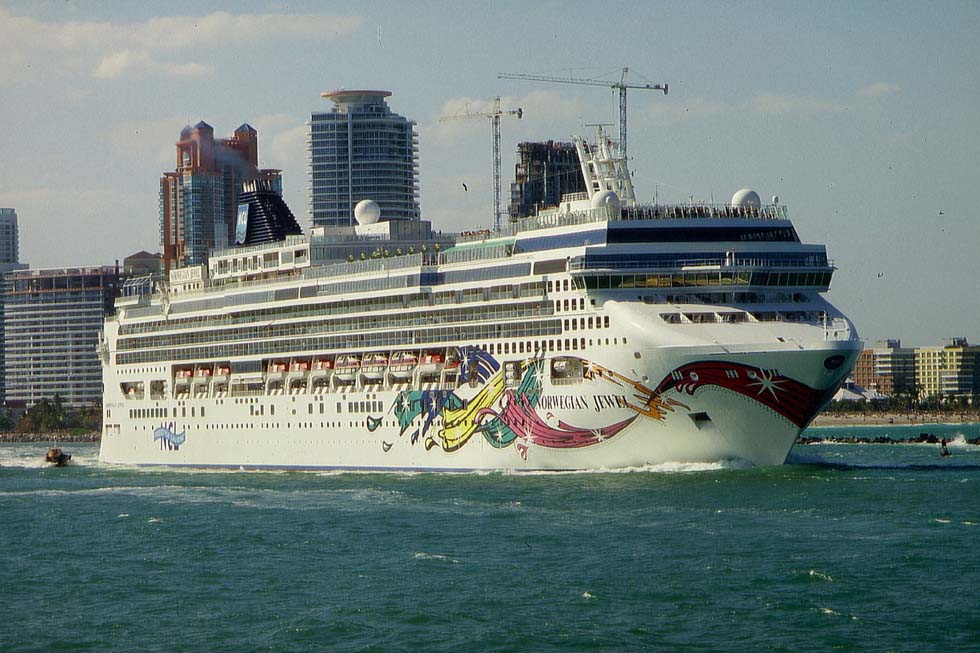
“Norwegian Jewel” of the 92,000-ton class, Miami 2007 (WS)
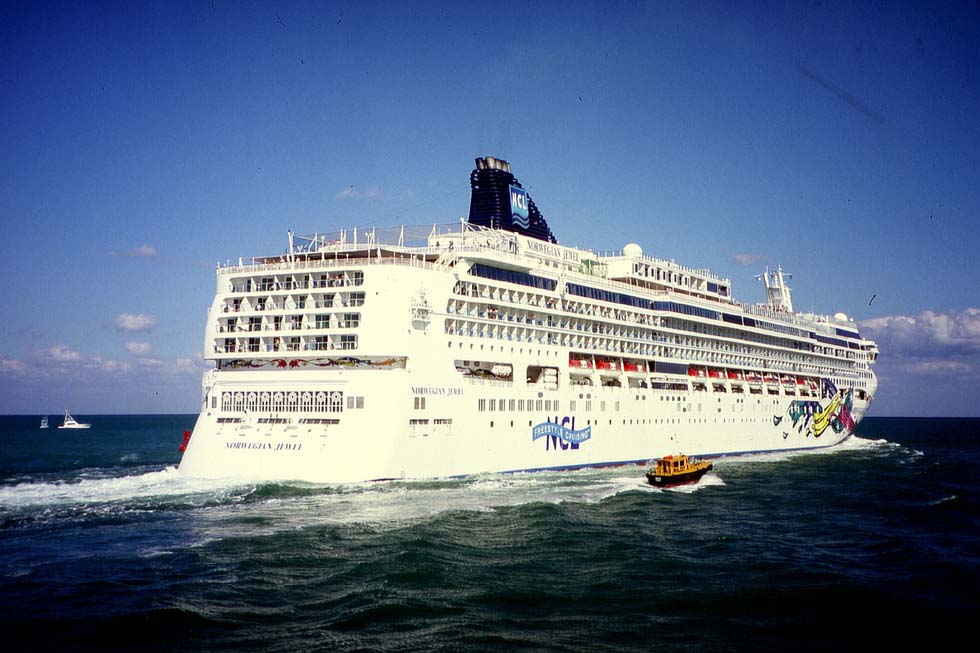
“Norwegian Jewel”, departing from Miami 2007 (WS)
The first two 150,000-ton megaships were commissioned in 2006 at Saint-Nazaire for completion in 2009, both with a total value of 1.47 billion euro. An innovative cabin design layout by Tillberg was praised, all outside staterooms being equipped with balcony. Cruise Mates’ Web site mentioned also a “highly unusual design, with no main dining room or theater.” Option for a third F3 was abandoned in 2007. In the same year, Apollo Management, owner also of ultra-luxury Regent Seven Seas Cruises, acquired a 50% share in NCL and invested $1 billion. Changes in design reportedly led to disputes. In October 2008 Cruise Business Review informed: “Aker Yards France suspends work on second F3 ship of NCL”. In late 2008 Ships Monthly reported considerations of selling the ships under construction. Finally completion of one F3 ship was confirmed. Propulsion is by 2 conventional propellers. The ship has a 2-storey theatre, a 3-storey main lobby and cabins of an innovative design with portholes along the floor and a separated ‘courtyard villa’ 1st-class. Compared to Royal Caribbean’s Freedom class ships with the ‘Royal Promenade’ and a passenger/space ratio of c.43, the ratio of the F3 is with 36.4 markedly economical, comparable to equally new Carnival ships. The ship’s uncommon design, characterized by the 1st-class block placed high above the navigation bridge, was not appreciated by the Berlitz guide. In May and June 2010, weeks before completion of the ship by STX France, the shipyard at Saint-Nazaire, there were three fire incidents, “suspected to be an arson”, as Wikipedia reported it. Nevertheless the “Norwegian Epic” was delivered in time on 17 June 2010. For her maiden voyage the prominent itinerary from Southampton to New York was chosen.
NCL America
As the Jones Act prevented foreign-flagged vessels from sailing itineraries solely between U.S. ports, every Hawaii cruise had to include an extension to a foreign country. The United States Lines (American Classic Cruises) had commissioned two ships whose construction began in the USA, but after 9/11 the company got bankrupt. NCL ordered completion of one of them, the “Pride of the Americas”, by the Lloyd Werft at Bremerhaven. After declaration of insolvency of this shipyard and endless discussions, Lloyd Werft delivered the “Pride of America” (80,493 gt) to NCL in 2005. As an originally U.S.-built ship she operates under the U.S.-flag brand NCL America and by a good deal also the former “Norwegian Sky”, renamed “Pride of Aloha” in 2004, and the new “Pride of Hawaii” joined that fleet, sailing quasi-monopoly Hawaii round-trips from Honolulu. As the ships must be U.S.-crewed, expense and fares proved comparatively high and the “Pride of Hawaii” as well as the “Pride of Aloha” (both not US-built) were withdrawn from Hawaii services. The “Pride of Hawaii” became the “Norwegian Jade” and the “Pride of Aloha” was renamed “Norwegian Sky”, relocated to other services. It’s an oddity that Hawaii cruises must be made aboard US-built ships, as the USA does not build cruise ships. The Jones Act, on which the concept of NCL America is based, was called into question in 2010 by Senator McCaine, in vain. Norwegian Cruise Line advertised e.g. in 2013 Hawaiian Island round trips only with the “Pride of America”, no longer under the label NCL America. Berlitz Guide 2011 informed that NCL America was merged completely into Norwegian Cruise Line. Competitor Princess Cruises obeyed the Jones Act by adding to Los Angeles – Hawaii cruises an intermediate stop at Ensenada in Mexico. Another matter are NCL’s cruises to Alaska, departing from Vancouver in Canada for Anchorage, including a voyage aboard the blue/yellow express of the Alaska Railroad with the historic dome-car.
In 2003 NCL informed that they had bought the legendary record holder “United States” as well as the old 1951-built S.S. “Independence”. In 2007 plans with the “Independence”, renamed “Oceanic”, were shelved. However, the Philadelphia Inquirer informed about intentions of the then NCL chairman C. Veitch concerning the “United States”: “He is not giving up on the 55-year old vessel. He said he has drafts of plans to add one or two decks and other amenities, and thinks renovating the “United States” would be a fantastic project”. There was the idea of employing the “United States” on worldwide cruises. In March 2009 however the magazine Ferries informed that owner Star Cruises wants to get rid of the “United States” and in 2011 the ownership changed to the SS United States Conservancy.
NCL’s Future
About the ownership of NCL in 2010, the year when the “Norwegian Epic” entered service, ShipsMonthly (Jan 2011) has reported that NCL is equally owned by Genting Hong Kong (formerly Star Cruises) and the Apollo Group. Ownership of Norwegian Cruise Line was reported (via Wikipedia in 2014) by Norwegian Cruise Lines Holdings with major shareholders including Genting Group (28.0%), Apollo Management (20.0%) and a minor share by TGP Capital. In 2010 NCL has created a sensation by announcing newbuilds of a completely different design, turning away from the “Epic” look. The Meyer Werft got order to deliver 2 ships of c.144,000 gt for c.4,000 passengers each in 2013 and 2014. They are of a futuristic appearance, resembling slightly the Solstice class developed for Celebrity, a step into future, and they are showing a new paint scheme by Peter Max. The “Norwegian Breakaway” was delivered on 25 April 2013, for cruises out of New York, followed by sister “Norwegian Getaway”, to be homeported in Miami. Then Wikipedia reported a second agreement with the Meyer Werft for vessels of a still larger size of 163,000 gt for 4,200 passengers, the Breakaway Plus class.
And a gradual exit of the Genting group was reported.
Ship classes commissioned for delivery from 2000:
Dawn class
Meyer Werft, 2 pods: “Norwegian Star” (2001/ 91,740 gt, commissioned as “Superstar Libra”, Star Cruises), “Norwegian Dawn” (2002/ 92,250 gt, commissioned as “Superstar Scorpio”, Star Cruises).
Jewel class
Meyer Werft, 2 pods: “Norwegian Jewel” (2005/ 93,502 gt), “Pride of Hawaii” (2006, later renamed “Norwegian Jade”), “Norwegian Pearl” (2006), “Norwegian Gem” (2007/ 93,530 gt each).
F3 class
STX France: “Norwegian Epic” (2010/ 155,873 gt).
Breakaway class
Meyer Werft: “Norwegian Breakaway” (2013/ 144,017 gt), “Norwegian Getaway” (2014/ 146,600 gt).
Breakaway Plus class
Meyer Werft, 163,300 gt: “Norwegian Escape” (2015), “Norwegian Bliss” (2017).
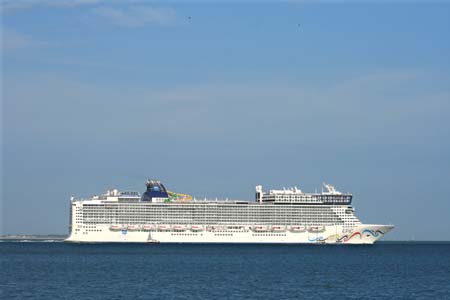
“Norwegian Epic” eastward bound from Southampton on maiden voyage to New York, June 24, 2010 (George Hutchinson, via Wikimedia)
|
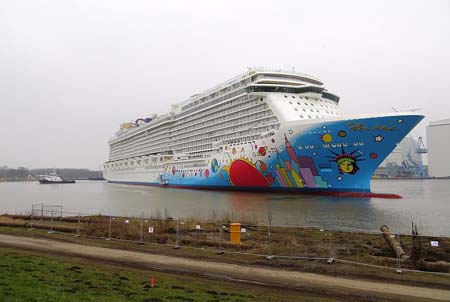
“Norwegian Breakaway”, Feb 2013 (Dickelbers, via Wikimedia)
|
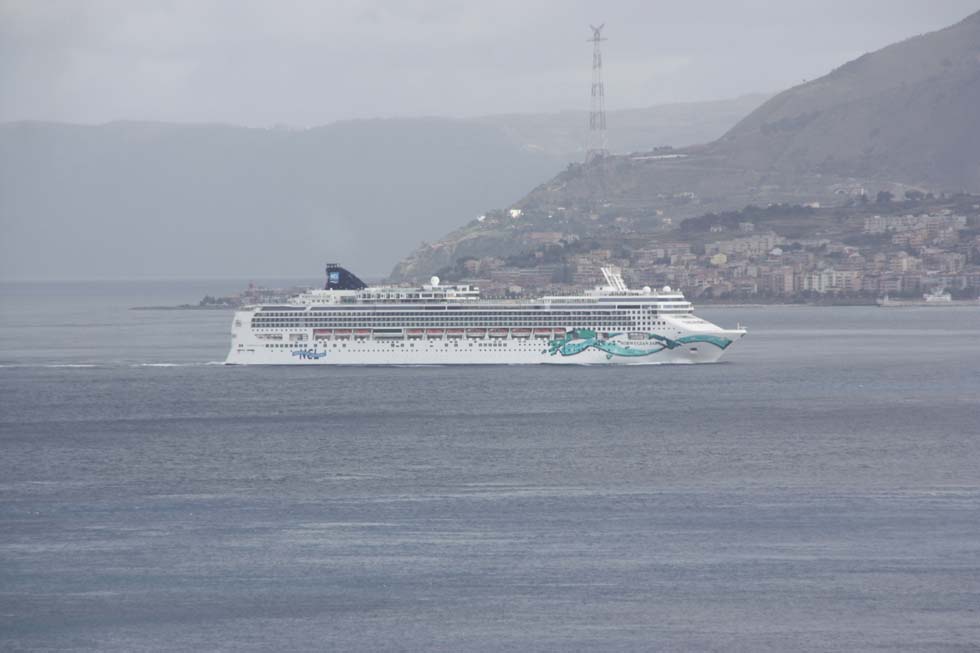
“Norwegian Jade”, ex “Pride of Hawaii”, Messina 2013 (Anton Soelch)
|




